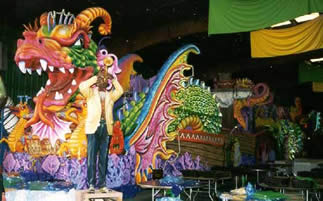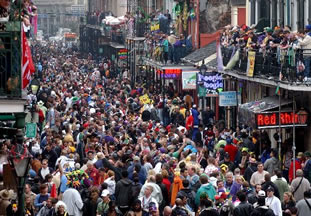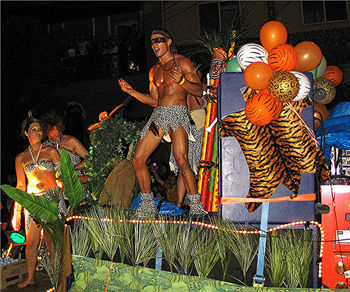What is Mardi Gras?
 Mardi Gras (French for “Fat Tuesday”) is the day before Ash Wednesday, and is also called “Shrove Tuesday” or “Pancake Day”. It is the final day of Carnival. It is a celebration that is held just before the beginning of the Christian liturgical season of Lent.
Mardi Gras (French for “Fat Tuesday”) is the day before Ash Wednesday, and is also called “Shrove Tuesday” or “Pancake Day”. It is the final day of Carnival. It is a celebration that is held just before the beginning of the Christian liturgical season of Lent.
The date is always on Tuesday and can vary from February 3 to March 9 in non-leap years or February 4 to March 9 in leap years. Like Lent, the date is dependent on that of Easter.
For more information, go to the list of dates for Mardi Gras for future years.
Perhaps the cities most famous for their Mardi Gras celebrations include New Orleans, Mobile, Rio de Janeiro, São Paulo, Venice, Salvador da Bahia, and Mazatlán. Many other places have important Mardi Gras celebrations as well. The carnival is an important celebration in most of Europe, and in many parts of Latin America and the Caribbean. Panama’s carnivals are gaining notoriety each year, with tourists from the U.S., Latin American and European countries increasing year after year.
 In Brazil, the Carnival celebrations in Recife, Olinda, Salvador are well-known, among others, most notably Rio de Janeiro. The annual Carnival that is held in Rio de Janeiro in Brazil is related to Mardi Gras. The celebrations of the Carnival end on Mardi Gras. This festival is an annual event that is held 2 weeks before the traditional Christian fasting of Lent. Thousands of people from across Brazil and also from other parts of the world come to attend the festivities. Carnival comes with a lot of music, good food, color and of course the Samba dance. Mardi Gras, the last day, is an added attraction.
In Brazil, the Carnival celebrations in Recife, Olinda, Salvador are well-known, among others, most notably Rio de Janeiro. The annual Carnival that is held in Rio de Janeiro in Brazil is related to Mardi Gras. The celebrations of the Carnival end on Mardi Gras. This festival is an annual event that is held 2 weeks before the traditional Christian fasting of Lent. Thousands of people from across Brazil and also from other parts of the world come to attend the festivities. Carnival comes with a lot of music, good food, color and of course the Samba dance. Mardi Gras, the last day, is an added attraction.
Carnival is celebrated in several Argentine cities in the subtropical northeast. Carnival in Buenos Aires is notable for the dancing murga troupes.
While not observed nationally throughout the United States, a number of cities and regions in the country have notable celebrations. Mardi Gras arrived in North America with the Le Moyne brothers, Pierre Le Moyne d’Iberville and Jean-Baptiste Le Moyne de Bienville, in the late 17th century, when King Louis XIV sent the pair to defend France’s claim on the territory of Louisianne, which included what are now the U.S. states of Alabama, Mississippi, and Louisiana.
 The expedition, led by Iberville, entered the mouth of the Mississippi River on the evening of March 2, 1699 Lundi Gras, not yet knowing it was the great river explored and claimed for France by de La Salle in 1683. The party proceeded upstream to a place on the west bank about 60 miles downriver from present-day New Orleans, where a small tributary emptied into the great river, and made camp. It was March 3, 1699… Mardi Gras, so in honor of this holiday, Iberville named the spot Point du Mardi Gras (French: “Mardi Gras Point”) and called the small tributary Bayou Mardi Gras enlou. In 1699, the traditional Catholic celebration ensued leading to what many refer to as “North America’s first Mardi Gras”. Between 1700-1702, Bienville founded the settlement of Mobile (Alabama), as the first capital of French Louisiana, and in 1703, the American Mardi Gras tradition began with French annual celebrations in Mobile. Year 1704 began with the masked ball, Masque De La Mobile, and in 1711, Mobile began the first parades. By 1720, Biloxi became the 2nd capital of Louisiana. The French customs were adopted there, and Mardi Gras is still celebrated along the Mississippi Gulf Coast to this day.
The expedition, led by Iberville, entered the mouth of the Mississippi River on the evening of March 2, 1699 Lundi Gras, not yet knowing it was the great river explored and claimed for France by de La Salle in 1683. The party proceeded upstream to a place on the west bank about 60 miles downriver from present-day New Orleans, where a small tributary emptied into the great river, and made camp. It was March 3, 1699… Mardi Gras, so in honor of this holiday, Iberville named the spot Point du Mardi Gras (French: “Mardi Gras Point”) and called the small tributary Bayou Mardi Gras enlou. In 1699, the traditional Catholic celebration ensued leading to what many refer to as “North America’s first Mardi Gras”. Between 1700-1702, Bienville founded the settlement of Mobile (Alabama), as the first capital of French Louisiana, and in 1703, the American Mardi Gras tradition began with French annual celebrations in Mobile. Year 1704 began with the masked ball, Masque De La Mobile, and in 1711, Mobile began the first parades. By 1720, Biloxi became the 2nd capital of Louisiana. The French customs were adopted there, and Mardi Gras is still celebrated along the Mississippi Gulf Coast to this day.
In 1723, the capital of Louisiana was moved, due to fear of tides and hurricanes, to an inland harbor town founded 1718 called “Nouvelle-Orléans” (New Orleans), and the tradition, which had started 20 years earlier in Mobile, was expanded. Nearly 125 years after Mobile’s first parade of 1711, a krewe from Mobile, the Cowbellion de Rakin Society (1830), began the first known parades in New Orleans (1835). Over the passing decades, following their European customs, Carnival celebrations took place in all towns and cities in the colony. Mardi Gras Carnival celebrations became an annual event highlighted by lavish balls and masked spectacles, such as Masque de la Mobile from 1704. Some were small, private parties with select guest-lists, while others were raucous, public affairs.





I have bookmarked this informativ site. Thanks Kfz Versicherung
S
They have a great on in Mazatlan, I own a condo there and go to it as often as I can when the mardi gras is happening. It’s a hoo ya good time!
Is that all you have?